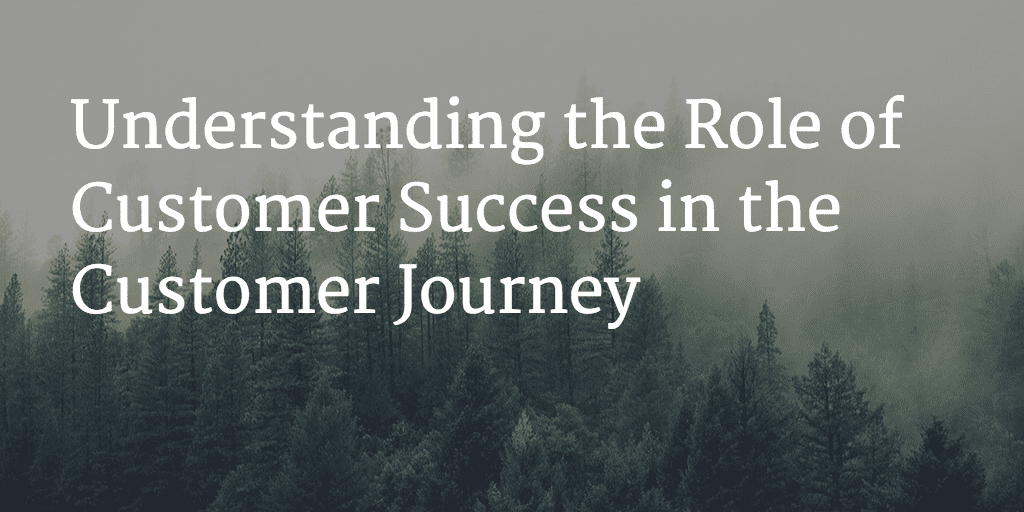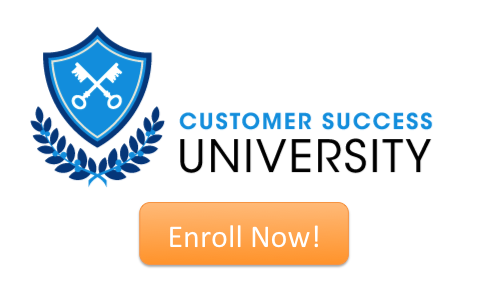When you create your customer journey map, outline the process your customers take to that first “Wow!” moment and eventually onto realizing value and achieving success, you must do so with them in mind. Obviously.
But how do you overlay what happens on your side to ensure that success map is followed; that your customers stay on course to move from point A, to B, to C, to… Success (and beyond)?
That’s what I’m going to cover here. But, because of the myriad ways that Customer Success teams are organized and the responsibilities assigned to them, defining one consistent Customer Success process for all situations is a very difficult task.
So what I will do here is define the end-to-end customer journey – from the perspective of Customer Success – assuming that all of the functional roles outlined in this previous article are separate organizations.
Now, if you find yourself in a situation where you are performing some combination of those roles, the overall customer journey will be the same but the handoff from organization to organization may not happen as frequently.
Okay, let’s take the customer journey step-by-step and outline Customer Success’ involvement or requirements:
1. Sales
Everyone understands that there is a Sales process that leads a prospect into becoming a customer. Sometimes this process happens completely online but, more often in the Enterprise world, this process involves a Sales person. In either case, something, or someone, compels the prospect to become a paying customer.
At the end of this process, the customer signs a contract which outlines what they have purchased along with the terms (length of contract, price, delivery promises, etc.). In many cases, there may also be a Services Statement of Work (SOW) defining how the product will be implemented and the resources required by both the customer and the vendor.
Customer Success Involvement – typically very little but there are exceptions. Some customers will want to delve deeply into how they will be cared for after the Sale is completed. This is something Sales will be trained to discuss but there may be times when a Customer Success Manager (CSM) or CSM leader will be brought into the Sales process to outline what the customer should expect after the contract signature and to reassure them that they will be well taken care of.
Customer Success Requirements – it’s extremely important that the value proposition and business use cases for which the customer purchased your product, are documented and passed to the post-Sales organization(s). For the CSM, this is critical because your responsibility will initially be to ensure that the promised use cases come to complete fruition.
This is what the customer has every right to expect and, to a large degree, defines your goals for the first 90-180 days of the customer’s lifecycle. It’s not usually easy to get Sales to create a detailed document outlining the use cases so success in getting this document usually happens in one of two ways – 1) Sales Consultants (SCs) may take on this task of documentation and are more likely to articulate the use cases clearly or 2) a meeting with the Sales team where a thorough Q&A is completed for the post-Sales team(s).
Now, what happens immediately after the deal is closed can make or break your relationship with the customer!
2. OnBoarding
As I laid out in the Functional Roles of Customer Success article, this is the team/process that results in the customer having a working installation of your product. This process can take anywhere from 2 days to 2 years. This obviously means that the outcomes could be very different. If the implementation process is short (less than 30 days), the likelihood is that every customer is using the product in a very similar way, or at least with a very similar configuration.
Longer onboarding projects in general typically mean that there is a lot of complexity and/or configurability in your product that that each customer may exit the onboarding project with some use cases that are very specific to their needs.
Customer Success Involvement – as I’ve mentioned, in some cases the Customer Success team actually does the onboarding project but we’re analyzing the situation where that’s not the case. When a separate group is doing OnBoarding, the CSM is typically not involved at all until the handoff at the completion of the project. However, in some companies, the CSM may serve as the overall quarterback and account owner, in which case they may be an escalation point during OnBoarding if things are going wrong or need some additional attention.
Customer Success Requirements – as a CSM, understanding what happened during OnBoarding is critical for the future success of the customer (and you). The outcome of this project is the exact definition of how each of the customer’s use cases were implemented in your product and will serve as your roadmap for guiding your customer to full value.
Much like in the handoff from Sales, documentation is necessary so that nothing is lost in translation. In this case, the handoff is typically easier because the OnBoarding team and the CSMs basically speak the same language. But it’s also more critical because the customer will fully expect all of the nuances to be understood by the Customer Success team.
For more on the alignment of OnBoarding and Customer Success, read this article by Dan Steinman: OnBoarding/Customer Success Alignment.
That all said, onboarding is just a phase that encompasses certain subsets of functionality, process, modules, etc. and is often constrained by a timeframe, like the first 30, 90, or 180 days. It most likely doesn’t mean everything is complete, that the customer is now using every function, feature, or module, or even that they are using every seat or license that they paid for.
To ensure they continue to get value from, and increase the breadth and depth of use, of your product, the next group gets tagged in:
3. Customer Support
Healthy customers will interact with Customer Support on a regular basis. In fact, a sure sign of an at-risk customer is a lack of interaction with your Customer Support team. Customer Support will work with customers on break/fix situations. Bugs, error codes, performance issues, inaccurate documentation, and operations situations (servers down, website problems, etc.) are typical reasons for a customer to contact Support.
Customer Success Involvement – frequency and quality of your customer’s interaction with Customer Support are part of the overall picture of customer health and, therefore, extremely important to Customer Success. In most cases, the CSM will simply be an observer of these interactions, watching or at-risk situations caused by the frequency of Support cases or the length of time those cases remain open.
Active involvement will come when Customer Success pushes a customer situation over to Support or when customer challenges with Support create an escalation to Customer Success.
Customer Success Requirements – for the most part, the requirements of a CSM with regards to Support are simply to be informed. This may be as simple as each CSM having a login to the Support system to keep an eye on this, or it could involve an integration of the Support system with either your CRM or a Customer Success application so that the information about your customer’s interactions with Support is easily accessible at all times.
For more on the alignment of Customer Support and Customer Success, here’s another great article by Dan Steinman: Customer Support/Customer Success Alignment.
When Support isn’t enough, your customers may need to talk to:
4. Professional Services
This will be very similar to OnBoarding and, in many cases, will even be the same team. They will execute on additional engagements with customers to further customize/configure their implementation of your product and to drive additional value.
Customer Success Involvement – these additional Services opportunities will often come from Customer Success. As you get involved deeply with your customers, the need for deeper technical expertise, or more dedicated resources, will be apparent and will allow you to bring your Services team back in to address those needs.
In this case, the CSM will be responsible for the initial requirements but the Services team will typically do a detailed Statement of Work as the first part of the project.
Customer Success Requirements – the outcome of a Services engagement will affect Customer Success in almost the exact same way as the OnBoarding project and the documentation needs are also the same. It’s critical that the CSM understand how any additional Services engagement evolves the customer solution and will drive the CSM’s plan for adoption and increased value.
For more on the alignment of Customer Support and Customer Success, please this great article by Dan Steinman: Services/Customer Success Alignment.
Okay, so your customers are onboard, they have the bugs worked out, and they even had some custom work done. They’re realizing value from your product left and right… now its time for:
5. Renewals / Upsells / Cross-Sells
In the subscription economy – SaaS, Membership sites, Subscription Commerce – whether self-service or high-touch, the idea of “sales” never completely leaves the picture. Even if it’s not the original Sales Rep, someone has to renew contracts and sell more products to the existing customer base. This could be the same Sales person or could be two different teams.
Customer Success Involvement – remember again that we’re assuming each of these functions are different organizations although we know in reality, that CSMs often do one or both of these Sales jobs. In the situation where they are distinct, the CSM is deeply involved in both. In fact, I will argue that the successful growth of the install base (renewals and upsells) is the responsibility of the CSM, even if they do not execute on either the renewal or an upsell/ Everything the CSM does, should have in mind as a result, either the successful renewal or an upsell opportunity or both.
By the way, to see exactly how Up/Cross-Sell impact Customer Churn and – ultimately – Customer Lifetime Value, get the slides or watch the video from our recent webinar with McKinsey & Company.
Customer Success Requirements – in this case, the requirements are on the CSM to communicate to the Sales person. In a renewal example, the CSM should be communicating the success of the customer, the ROI that the customer has received (if tracked) and any challenges they’ve had. The result of this communication will arm the Sales person for the renewal discussion, either confident or cautious.
In the case of upsell, the CSM will often be the lead generation engine for these opportunities. Knowing the customer and their needs better than anyone, these upsell opps will arise naturally in the conversation, both for product and additional services.
As you can see, the path to get the customer to success in a typical Enterprise SaaS company is pretty complicated. As a CSM, you are ultimately the glue that ties the various pieces together as you are the one responsible for maximizing the Lifetime Value (LTV) of the customer and delivering a superior customer experience.
You will also own, at least partially, the responsibility for helping each of the other organizations refine their processes and outcomes to better serve the customer over their lifetime.
Oh, the best way to ensure you have high-performing Customer Success Managers that fully understand how they fit into the Customer Journey is to enroll them in Customer Success University now.


